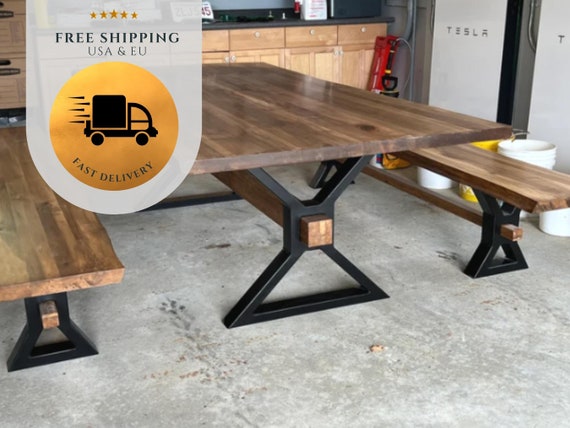How to Choose the Perfect Dining Room Table Legs for Your Home Design
How to Choose the Perfect Dining Room Table Legs for Your Home Design
Blog Article
A Thorough Take A Look At Eating Table Leg Styles: Locating the Ideal Match
Choosing the appropriate dining table leg style is vital for both visual allure and useful capability. For those with bigger tables, trestle legs make sure tough assistance, whereas hairpin legs present a mid-century contemporary ambiance with their minimal design. The x-shaped legs mix modern design with improved security.
Standard Four Legs
Amongst the numerous sorts of table leg styles, the conventional four-leg layout remains a timeless option for lots of homes. This classic setup provides an unified mix of performance and visual appeals, making it a seasonal fave. Four legs offer well balanced support, making certain the table continues to be stable and capable of bearing significant weight. This is especially beneficial for households that frequently organize large events or use their eating table for numerous functions, such as work or crafting.
From a visual viewpoint, the standard four-leg design can be quickly adapted to various interior styles. Whether crafted from wood, metal, or a mix of materials, these legs can be elaborately carved, streamlined and minimalistic, or anything in between. Their adaptability enables them to match both rustic and contemporary settings flawlessly.
Furthermore, the simple structure of the four-leg layout promotes simplicity of movement and positioning within a room. Unlike even more complex bases, this style decreases blockages, providing adequate legroom for diners. In summary, the typical four-leg table leg style marries withstanding beauty with sensible capability, making it an astute selection for those seeking both form and function in their dining furniture.
Pedestal Base
Frequently celebrated for its sophisticated and space-efficient layout, the stand base is a distinguished option to the standard four-leg setup in dining table leg styles. Without corner legs, restaurants are managed higher freedom of motion, making it an optimal choice for round and oval tables that promote even more intimate and comprehensive events.
Moreover, the stand base's main assistance can handle significant weight, permitting making use of larger tabletops, such as marble or thick hardwood. This toughness combined with its visual convenience makes the stand base a preferred choice in both standard and contemporary indoor setups. It can effortlessly incorporate with numerous layout motifs, from timeless elegance to minimal modernity. The central column itself supplies a canvas for elaborate designs and artistic expressions, including an element of visual rate of interest underneath the table. In recap, the pedestal base incorporates capability with design, click for more making it a refined and useful alternative for varied dining environments.
Trestle Legs
Trestle legs supply a robust and classic structure for eating tables, defined by their straight cross-bracing and durable support beam of lights. Originating from medieval times, this design has actually advanced yet preserved its essential framework, making it a seasonal fave in both standard and modern setups. The main trestle beam, commonly sustained by two or more upright blog posts, supplies phenomenal security, permitting bigger table sizes without the need for extra legs.
A substantial benefit of trestle leg tables is the sufficient legroom they provide. Unlike tables with four corner legs, the lack of obstructions at the table's use this link sides provides unobstructed area for chairs and diners, improving comfort and availability. This makes trestle tables excellent for fitting larger events, whether in a dining area or a banquet hall.
From rustic farmhouse to sleek contemporary styles, trestle legs can be personalized to match private tastes. Their enduring appeal and functional advantages make trestle legs an engaging option for those seeking both design and usefulness in their eating table.
Hairpin Legs

The charm of hairpin legs hinges on their simpleness and adaptability - dining room table legs. Offered in a variety of materials, including steel and brass, they can be finished in various colors to complement different indoor designs. Whether coupled with a rustic wood tabletop or a contemporary glass surface area, hairpin legs effortlessly mix functionality with a touch of vintage appeal
Toughness is another notable attribute of hairpin legs. site link In spite of their fragile look, these legs are crafted to birth significant weight, ensuring the dining table remains stable and safe and secure. Furthermore, they are fairly easy to mount, making them a prominent option for do it yourself enthusiasts and specialist furnishings makers alike.
X-Shaped Legs

Created from materials such as steel, timber, or a combination of both, X-shaped legs can be tailored to match various design preferences. Steel legs usually provide a streamlined and commercial feel, ideal for loft-style houses and contemporary eating areas.
In addition, the engineering behind X-shaped legs ensures even weight distribution, lessening the danger of tottering and enhancing resilience. This makes them especially well-suited for bigger eating tables that call for added assistance. Basically, X-shaped legs mix useful design with contemporary aesthetics, making them an ageless selection for varied eating settings.
Conclusion
An extensive understanding of eating table leg styles exposes the distinct attributes and benefits of each layout. Standard four legs use security and timeless charm, while pedestal bases supply legroom and a structured appearance. Trestle legs make sure durable assistance for larger tables, and hairpin legs present a mid-century modern visual. X-shaped legs incorporate modern style with boosted stability. Picking the appropriate leg style ensures both functional and aesthetic fulfillment in any dining area.
Report this page